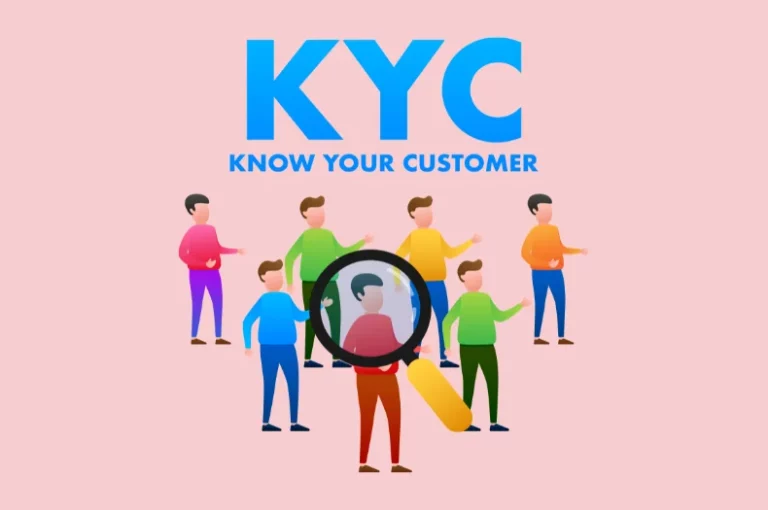

Introduction
The importance of CKYC (Central Know Your Customer) in financial institutions cannot be overstated. For any financial institution or business, adhering to regulations and protecting customer interests is paramount. CKYC Registry Fillings, being one of the most significant regulations, is essential to understand. As of March 2023, the CKYC registry boasts more than 70 crore records. Moreover, the CKYC system is more reliable and stable compared to other systems like the Aadhar UIDAI server.
However, many financial institutions and lending businesses are still grappling with the concept of CKYC. Some are not even aware of its existence, highlighting the need for more awareness and understanding of this critical regulation. We have recognized this gap and decided to shed light on the importance of CKYC in financial institutions. We aim to discuss the basic roots of CKYC, its functionalities, and how financial institutions can ensure their systems are automated, seamless, and compliant.
.elementor-widget-video .elementor-widget-container{overflow:hidden;transform:translateZ(0)}.elementor-widget-video .elementor-wrapper iframe,.elementor-widget-video .elementor-wrapper video{height:100%;width:100%;border:none;background-color:#000}.elementor-widget-video .elementor-open-inline .elementor-custom-embed-image-overlay{position:absolute;top:0;left:0;width:100%;height:100%;background-size:cover;background-position:50%}.elementor-widget-video .elementor-custom-embed-image-overlay{cursor:pointer;text-align:center}.elementor-widget-video .elementor-custom-embed-image-overlay:hover .elementor-custom-embed-play i{opacity:1}.elementor-widget-video .elementor-custom-embed-image-overlay img{display:block;width:100%}.elementor-widget-video .e-hosted-video .elementor-video{-o-object-fit:cover;object-fit:cover}.e-con-inner>.elementor-widget-video,.e-con>.elementor-widget-video{width:var(–container-widget-width);–flex-grow:var(–container-widget-flex-grow)}
What is CKYC and why is it important?
CKYC, or Central Know Your Customer, serves as a centralized repository for KYC data. Before its implementation, customers had to submit separate KYC documents to each financial institution they interacted with. This often led to inconsistencies and outdated information. With Central Know Your Customer initiative, once a customer’s KYC data is submitted to any financial institution, it’s pushed to the CKYC registry. Other institutions, with the customer’s consent, can then pull this data, ensuring they always have the most up-to-date information.
A CKYC software solution sits in the middle of this process, facilitating the request and response of this data through APIs. This centralization has several benefits:
- Alternate to Aadhar: Many financial institutions now use CKYC process as an alternative to Aadhar for KYC verification. This is especially useful when the Aadhar mobile number isn’t mapped or when the Aadhar server is down.
- Multiple Valid Documents: CKYC system accepts various valid documents, including Aadhar, PAN, driving license, and voter ID. Once a customer’s data is in the CKYC registry, institutions can retrieve the information using any of these IDs.
- Ease of Use: CKYC server provides a more stable and user-friendly experience compared to other systems.
- Inter-usability of KYC records across financial institutions.
- Reduce the burden of constantly producing and verifying KYC for a new financial institution.




You may also like: CKYC Software Solution
Functionalities of CKYC
Search
This function allows institutions to search for a customer’s CKYC number using various identification numbers, such as PAN. By inputting the PAN number, institutions can retrieve the CKYC number along with some personal details like name, father’s name, and mother’s name.
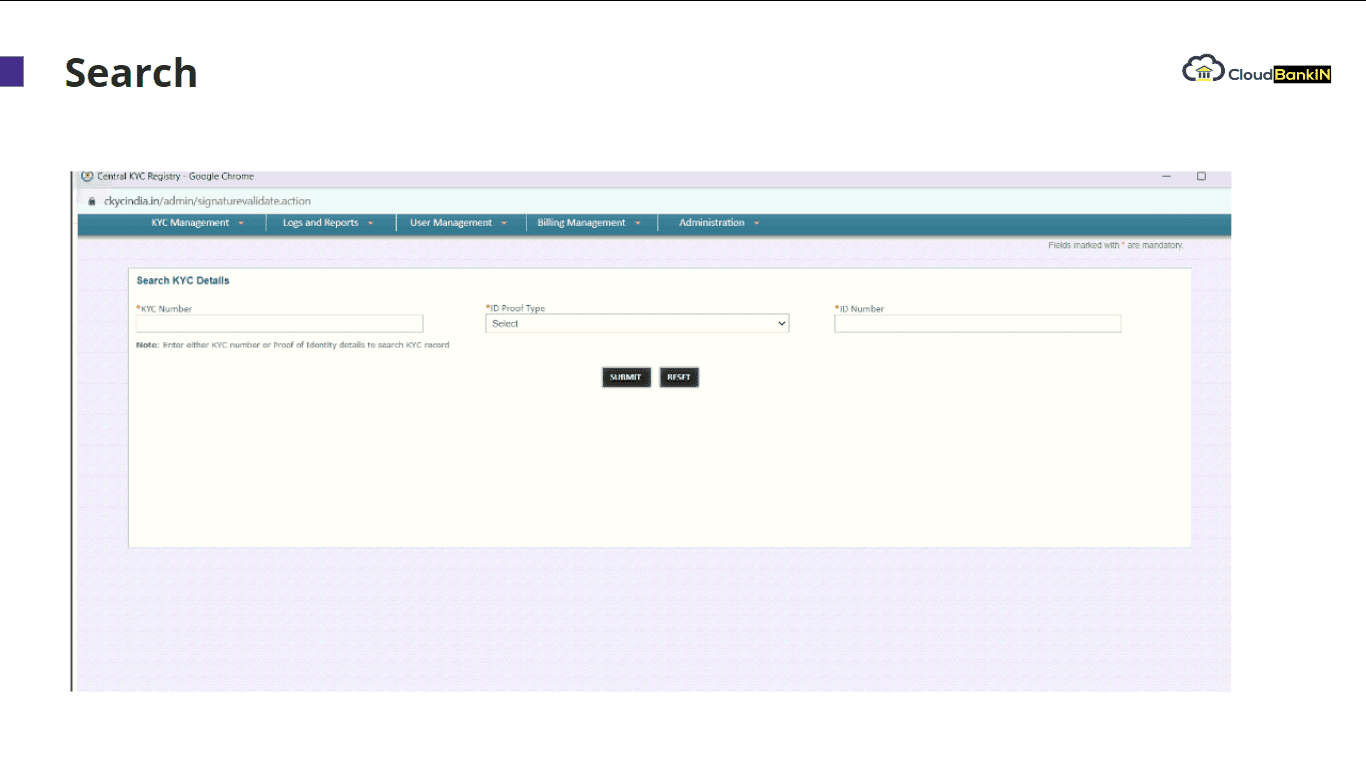

Download
Once the CKYC number is obtained, institutions can use the download function to retrieve all the information submitted by the customer during their CKYC registration.


Upload
There are two main functionalities under upload:
- New User Creation: Institutions can create a new CKYC record by filling in various sections like personal details, address, related person details, and other relevant information.
- Update Existing User: If a record was created by the same institution, it can be updated directly. Otherwise, the record must first be downloaded before any updates can be made.
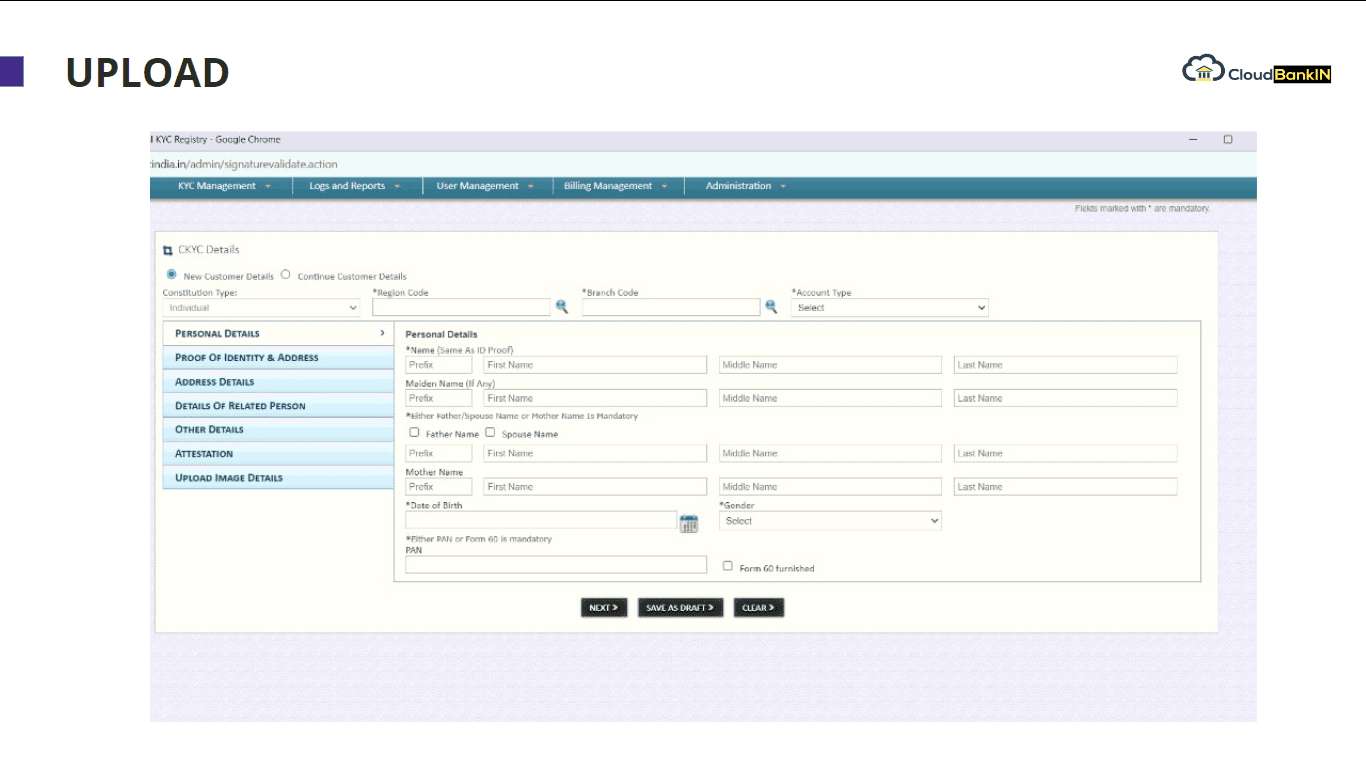

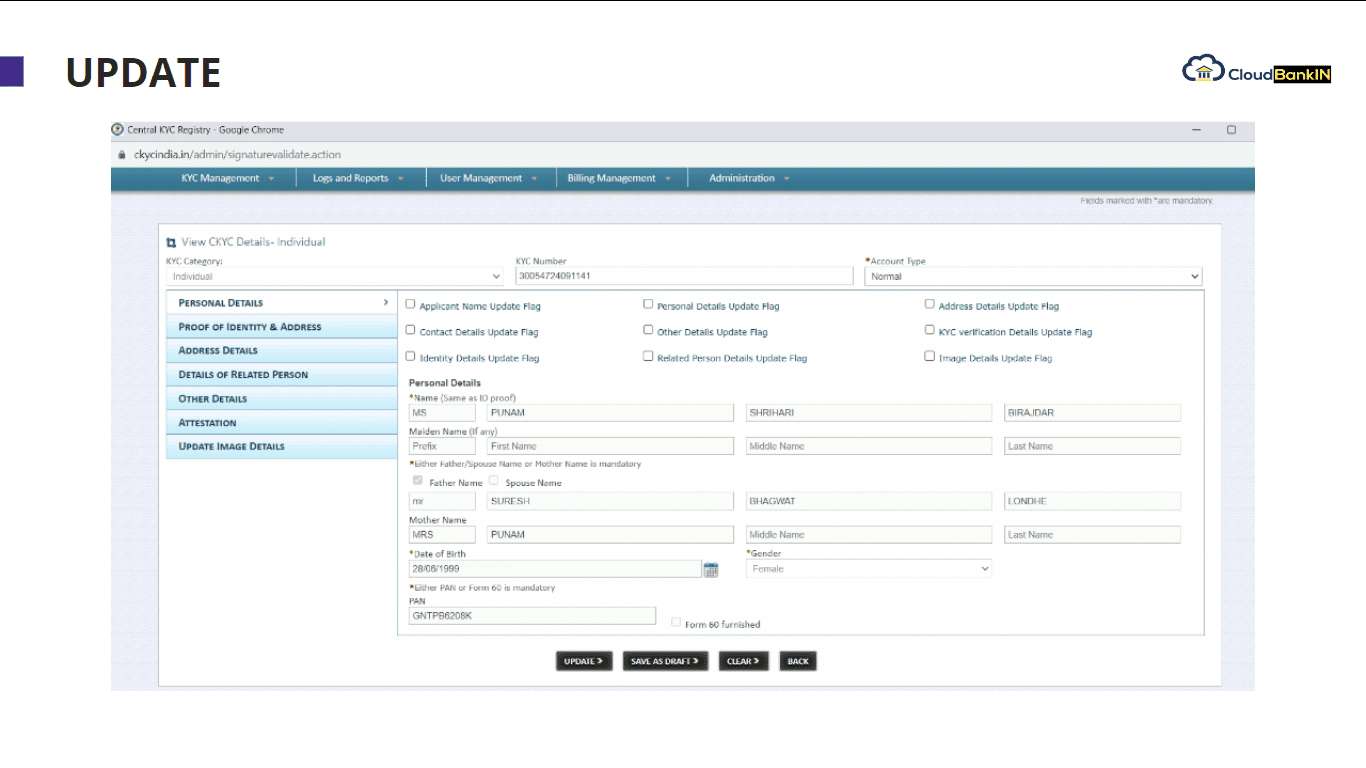

CKYC Pricing
One of the standout features of CKYC, especially when compared to similar systems in other countries, is its cost-effectiveness. For instance:
- Search: This feature is available at no cost.
- Upload, Download, and Update: The cost for these operations is approx. one rupee each respectively. This nominal fee for CKYC functionalities makes them an attractive option for financial institutions looking to streamline their KYC processes without incurring high costs.
|
Services |
Price in INR |
|
CKYC – Search |
0 |
|
CKYC – Upload |
0.80 |
|
CKYC – Download |
1.10 |
|
CKYC – Update |
1.15 |
CKYC API – Search
Here’s how the CKYC API for search works:
- Integration with Loan Origination Process: When a borrower applies for a loan, they can be onboarded through various methods, such as self-onboarding, loan officers, or DSAs. As part of the loan origination process, the borrower provides basic details, including their PAN and date of birth.
- Instant Data Retrieval: Upon entering the PAN and date of birth and obtaining the borrower’s consent, the financial institution can instantly pull the borrower’s CKYC data. This is facilitated by the CKYC search API, which retrieves the CKYC ID (a 14-digit number), address, date of birth, and other relevant details.
- Automation through API: The CKYC search API can be integrated into the financial institution’s system, allowing for real-time data retrieval. For instance, if a borrower’s Aadhar OTP verification fails, the CKYC details can serve as an alternative verification method.
- Using Postman for API Testing: For technology teams, the CKYC API can be tested using tools like Postman. By inputting the PAN number and sending a request, the API communicates with the CKYC portal, retrieves the relevant data, and displays it in Postman. The primary output of the search API is the 14-digit CKYC number, name, and age of the borrower.
- Efficiency and Speed: The automation provided by the CKYC API ensures that financial institutions can quickly verify and onboard borrowers, enhancing the efficiency of the loan origination process.
View the complete workflow here.
CKYC API – Download
Here’s a breakdown of how the CKYC API for download operates:
- Data Retrieval: After obtaining the CKYC number through the search API, the download API can be invoked. By providing the CKYC number as input, financial institutions can instantly pull detailed information about the customer. This includes approximately 50 to 60 parameters, offering a comprehensive view of the customer’s data.
- Integration with Loan Origination Systems: The CKYC download API can be seamlessly integrated into loan origination systems. This ensures that when a borrower applies for a loan, their CKYC details can be instantly retrieved, streamlining the loan approval process.
- Automation through API: The CKYC download API can be tested and integrated using tools like Postman. By providing the CKYC number, the API fetches the detailed data, which includes a text file with all the customer’s details in a specific format (separated by pipe symbols). Additionally, the ZIP file generated contains identification documents provided by the customer, such as passport, Aadhar, and profile details.
- Efficiency: The automation provided by the CKYC download API ensures that financial institutions can quickly access detailed customer data without manual interventions. This not only speeds up the loan origination process but also ensures data accuracy.
View the complete workflow here.
CKYC API – Upload
Here’s a detailed overview of how the CKYC API for upload operates:
- Integration with Loan Origination Systems: The CKYC upload API can be integrated into loan origination systems, allowing institutions to automatically submit customer details to the CKYC registry.
- Automated File Generation: The API generates a ZIP file containing all the necessary customer details in the required format. This ZIP file includes a text file with customer details separated by pipe symbols and any identification documents provided by the customer, such as a passport and Aadhar.
- SFTP Workflow: Once the ZIP file is generated, it can be automatically uploaded to the CKYC registry either manually or via Secure File Transfer Protocol (SFTP). The CKYC system will then process the file, and a response file will be generated, indicating the completion of the upload process.
- Efficiency and Automation: The CKYC upload API eliminates the need for manual file creation and submission, ensuring that customer data is accurately and efficiently uploaded to the CKYC registry.
View the complete workflow here.
CKYC API – Update
Here’s how it operates:
- Identification of Existing Records: Before making any updates, it’s essential to identify the existing record. This is typically done using the CKYC number obtained from the search API.
- Data Modification: Once the record is identified, the CKYC update API allows institutions to modify specific details of the customer. This could include changes in address, contact details, or any other relevant information.
- Validation Process: To ensure data integrity, any updates made to a customer’s record go through a validation process. This involves a maker-checker mechanism where one user (the maker) initiates the update, and another user (the checker) reviews and approves the changes.
- Response Handling: After submitting the update request, the CKYC system processes the changes. A response is generated, indicating the status of the update. If there are any discrepancies or issues, the system will flag them, allowing institutions to rectify any errors.
View the complete workflow here.
SFTP Response Workflow
The SFTP response flow outlines the sequence of events that occur after data is uploaded via SFTP:
- Data Submission: Once the data is prepared and validated, it’s uploaded to the CKYC registry via SFTP.
- Data Processing: The CKYC system processes the uploaded data, checking for accuracy and ensuring that it meets the required standards.
- Response Generation: Once the data is processed, the system will produce responses in three stages:
a) Initially, after the SFTP upload is done, an immediate response named ‘response_0‘ will be generated in the ‘SFTP response’ folder. This is primarily to confirm the correctness of the data format.
b) During the Checker phase, this initial response is also used for authority purposes. Upon its acceptance, another response, ‘response_1’, is generated.
c) Within ‘response_1′, an 11-digit reference number is provided, which allows you to monitor the upload’s progress. The conclusive feedback, which will denote either acceptance or rejection, will be generated in 24 hours.
- Error Handling: If there are any discrepancies or errors in the uploaded data, the CKYC system will flag them. Institutions can then review the feedback, rectify any errors, and re-upload the corrected data.
- Final Verification: Once all errors are addressed and the data is re-uploaded, it undergoes a final verification process. Upon successful verification, the data is added to the CKYC registry.
View the complete workflow here.
You may also like: A Comprehensive Guide to CKYC Registration for Financial Institutions
Conclusion
The CKYC process, with its centralized approach, is not just reshaping but revolutionizing the KYC landscape. By focusing on automation, efficiency, and cost-effectiveness, it has positioned itself as a must-have tool for financial institutions. As we witness the financial sector undergoing rapid transformations, regulations such as CKYC fillings emerge as the backbone, ensuring unparalleled transparency, consistency, and compliance. In this dynamic environment, it’s crucial for institutions to stay ahead of the curve. Upgrading your financial system process is no longer just an option; it’s a necessity. If you’re keen on embracing this change and want to witness firsthand how CKYC can benefit your institution, get in touch with us for a comprehensive demo. Let’s embark on this journey of financial evolution together.
{
“@context”: “http://schema.org”,
“@type”: “Article”,
“name”: “Decoding the Key Parameters in Indian Credit Bureau Reports”,
“author”: {
“@type”: “Person”,
“name”: “Sweta Barua”
},
“datePublished”: “2023-07-17”,
“image”: “https://habiletechnologies.com/wp-content/uploads/2023/07/Decord-Credit-Report-Parameters-730×455.png”,
“articleSection”: “Introduction In today’s fast-paced financial world, credit plays a vital role in determining an individual’s ability to access various financial products and services. Whether it’s securing a loan for a dream home, obtaining a credit card, or even applying for a small personal loan, lenders in India rely on credit information to assess an individual’s creditworthiness and make informed lending decisions. At the heart of this credit evaluation process lies the credit bureau report, which provides a comprehensive snapshot of an individual’s credit history and financial behaviour. A lender pulls credit reports of their borrowers to determine whether they have the “intent” to pay loans or not. On the other hand, to determine the “ability” to pay, lenders pull documents like bank statements. In India, credit bureaus such as Credit Information Bureau (India) Limited (CIBIL), Equifax, Experian, and CRIF High Mark collect, analyze, and maintain credit information of individuals from various financial institutions and lenders across the country.”,
“articleBody”: “Additionally, credit bureau reports are integral parts of the loan origination system process. They are generally used in one of the 10 loan origination stages, aka Credit Bureau Check.
This blog highlights important parameters in an Indian credit bureau report, vital for individuals seeking credit and maintaining a healthy credit profile. Understanding these parameters reveals what lenders assess for creditworthiness and how individuals can improve their credit standing.
Join us to explore key parameters shaping credit bureau reports in India and their impact on financial opportunities and decisions.
Credit Bureau Overview
When it comes to evaluating creditworthiness, credit bureaus play a crucial role in the financial landscape of India. Let’s delve into the key aspects of credit bureaus in India.
- The credit bureaus act as repositories of credit data.
- They gather information from Banks, Urban Co-Operative Banks (UCBs) Non-Banking Financial Companies (NBFCs), credit card issuers, and other lending entities.
- The credit data encompasses details about credit accounts, repayment history, credit limits, outstanding balances, and more.
- Credit bureaus compile comprehensive credit information into credit reports (aka credit bureau reports), providing lenders with insights into an individual’s creditworthiness and helping them assess the risks of extending credit.
- Understanding the essential sections of credit bureau reports—credit scores, credit history, credit accounts, enquiries, and public records—is crucial for individuals to gauge their creditworthiness and make informed financial decisions.
It’s important to note that credit bureaus in India operate independently and employ different algorithms and methodologies to calculate credit scores. Thus, it is common for individuals to have credit scores that may vary slightly across different credit bureaus. However, the underlying parameters considered in credit reports remain fairly consistent across these institutions.
Now that we have a basic understanding of credit bureaus and their role in India’s financial ecosystem let’s delve deeper into the top parameters used in a credit bureau report.
You may also like: The Most Popular Credit Rating Agencies in India
Key Parameters in a Credit Bureau Report
1. Individual Information
What is it?
The Personal Information section contains details pertaining to the individual’s identity. This parameter aims to provide a comprehensive overview of the individual’s personal details as reported by lenders and Financial Institutions (FIs). Credit reporting is done for both borrower and co-borrower of a loan.
Why is it important?
It is primarily used for identification purposes and to triangulate data from all sources. It helps establish the individual’s unique identity and verify their personal details. Lenders and financial institutions rely on this information to match the borrower’s identity with their credit history and track any potential discrepancies. The accuracy of personal information is vital for conducting reliable credit assessments and preventing identity theft or fraud.
What does it include?
Full Name, Address, Date of Birth, Gender, Contact Details, PAN Card Details, Other Identifying Proof – Aadhaar Card number, Passport number, Voter ID, Driving License, Ration Card, or other official identification documents.
Note: If addresses and phone numbers keep changing frequently, it raises red flags about the borrower.
2. Credit Score
What is it?
A credit score is a three-digit number that falls within a range of 300 to 900. It is provided by credit bureaus. The score is based on an individual’s credit history, payment behaviour, credit utilization, and other factors. It serves as an indicator of how likely a person is to repay their debts on time.
Why is it important?
Lenders rely on credit scores to evaluate the creditworthiness of applicants. A higher credit score increases the chances of loan approval, while a lower score may lead to difficulties in obtaining credit or result in higher interest rates. Each credit bureau has its own set of criteria & algorithms to determine credit scores. Thus, different credit bureau reflects different score on a credit report. Maintaining a good credit score is essential for accessing favourable terms and financial opportunities.
What is a good credit score?
While credit score ranges may vary across different credit bureaus. A credit score which is 650 & above is typically considered as good. However, each lender may have its own criteria for assessing creditworthiness. It’s important to monitor your credit score regularly and strive for a higher score, as it improves your chances of loan approval and favourable interest rates.

(Image Credit: Forbes)
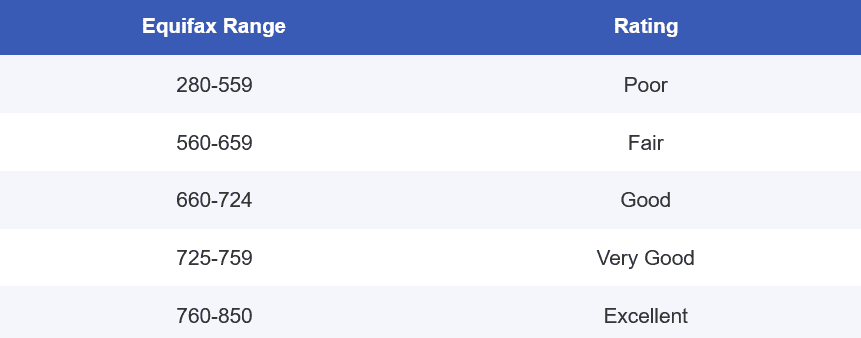
(Image Credit: Forbes)
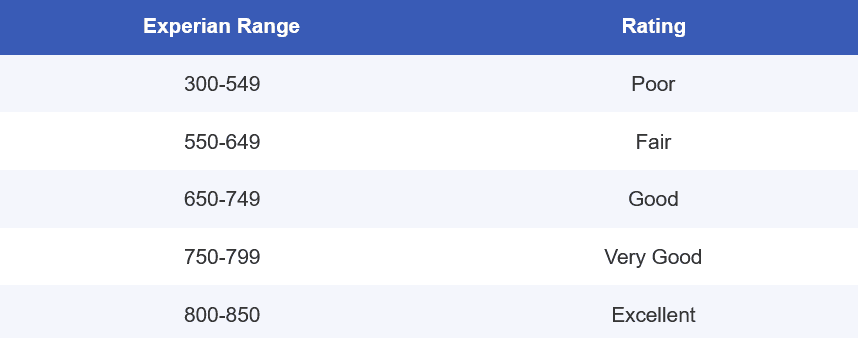
(Image Credit: Forbes)

(Image Credit: Forbes)
Based on what factors credit scores are evaluated?
- Payment History: It includes all your past and present payments to lenders, reflecting your reliability as a borrower. Unpaid bills can negatively impact your payment history and overall score.
- Credit Utilization Ratio (CUR): The percentage of available credit being used, usually on a credit card. For example, a credit card has ₹ 1,00,000 amount as the limit, out of which ₹ 10,000 is used already. Hence, CUR is 10,000/1,00,000, which is 10%. High CUR above 30% = bad credit management, indicating financial indiscipline & potential loan default. Keep CUR below 30% for healthy management of credit.
- Credit History Age: The duration for which you have been utilizing credit is what defines the age of your credit history. Lengthier credit history has a positive impact on your credit score.
- Credit Mix: Borrowers may possess different types of credit accounts, including education loans, mortgages, credit cards, and vehicle loans. This assortment of credit accounts is known as the credit mix. This determines how well a borrower is able to manage all kinds of credit.
- Credit Enquiries: Credit Enquiries are typically necessary when an individual seeks a loan or applies for a credit card. A lender does an enquiry to access a credit report for the borrower.
Factor | Impact |
Payment History | High |
Credit Utilization | High |
Credit Age | Medium |
Total Credit Accounts | Low |
Credit Enquiries | Low |
3. Account Information
What is it?
Account Information in the credit bureau report provides crucial details about your credit accounts, including loans and credit cards. It encompasses information about account types, payment history, account status, ownership, and more.
Why is it important?
- Credit History and Credibility: Account Information helps establish your credit history and credibility. Having multiple accounts, especially older ones, positively influences your credit score, demonstrating your experience in managing credit responsibly.
- Credit Mix and Score Impact: Account Information reveals the composition of your loan portfolio, including the mix of secured and unsecured loans. Maintaining a healthy mix can contribute to a higher credit score, indicating your ability to handle different types of credit.
- Lender’s Decision and Loan Eligibility: The information on your current loan balances and outstanding amounts directly affects a lender’s decision to grant you additional credit. High outstanding balances or long-term loans may lower your credit score and impact your loan eligibility.
- Payment History and Delays: Account Information provides insights into your payment patterns and any delays or defaults. Longer periods of delinquency can result in a lower credit score.
What information does it include?
- Account Identification: Account numbers, loan types, ownership details (individual or joint), and opening/closing dates.
- Account Status: Active or closed account status indicating your current credit relationships and credit history with specific lenders.
- Credit Limits and Usage: Credit limits assigned to each account, and your credit utilization ratio reflecting the amount of credit used compared to the total available.
- Payment History: Details on payment frequency, amounts due, actual payments made, and any payment delays.
- Secured and Unsecured Loans: Differentiating between loans with collateral (secured) and those without (unsecured), such as auto loans, home loans, and credit cards.
An Example of Account Information – CIBIL Report

Name | Description |
Account Terms | |
Account Number | Account number of the financial institution you have taken the loan from (in this case, a bank). |
Date Opened | When the loan account is opened. |
Date Closed | When the loan account is closed. |
Account Holder Type | What type of account it is, whether an individual, joint, etc. |
Account Description | |
Date Reported | Date on which data is submitted by that bank. |
Loan Type | The type of loan taken. |
Account Status | Account status is either active or closed. |
Highest Credit | The highest amount of payment owed by you to the bank. |
Current Balance | The amount left to be repaid when the report was generated. |
Account Past Due | The amount that’s not been paid on time, basically an overdue amount. |
Last Payment Date | Date on which the last payment was made when the report was generated. |
Account Details | |
Credit Limit Amt | Valid only for credit cards – the amount limit allowed to be withdrawn. |
EMI | The amount you are required to pay each month. |
Total Write-off Amt | The total loan amount defaulted. |
Principal Write-off | The total loan amount subtracting the interest amount. |
Settlement Amt | Both bank and you agree to settle the loan on a certain amount. |
4. Enquiries Information
What is it?
Credit enquiries refer to instances when your lender requests access to your credit report for a hard pull from a credit bureau. It is typically necessary when you ask for a loan or a credit card. These enquiries provide valuable information about your credit history and play a crucial role in determining your credit prospects.
Why is it important?
Enquiries are essential because they reflect your credit-seeking behaviour and provide insights into your creditworthiness. Lenders and financial institutions consider your credit enquiries when evaluating your loan or credit card applications.
How is it done?
- Soft Pull: Soft inquiries are created when you or financial institutions look into loan options. They usually happen when you ask for your credit report or when a creditor pre-screens you for loan eligibility.
- Hard Pull: When you apply for credit, lenders must check your credit report to see before extending you the credit or giving you a loan. These checks are called hard inquiries. It is important to note that hard enquiries are visible to lenders and can affect their decision to approve or reject your loan or credit card application.
How Do Enquiries Impact Credit Scores?
- Soft Enquiries: No direct impact on your credit score.
- Hard Enquiries: Each hard enquiry may lower your score by a few points (typically 5-10 points) temporarily, typically lasting a few months to a year. Hard inquiries are removed from your credit reports after a period of two years.
- Multiple Hard Enquiries: Having multiple hard enquiries within a short period shows your desperation, raises concerns and negatively affects your credit score for a longer duration.
5. Payment History
What is it?
Payment History in a credit bureau report reflects a borrower’s past payment behaviour on credit accounts, including timely payments, missed payments, defaults, and Days Past Due (DPD) information indicating payment delays.
Why is it important?
Payment History is one of the most significant factors considered by lenders when assessing your creditworthiness. It demonstrates your ability to manage credit responsibly and fulfil your financial commitments. A positive payment history, with a track record of timely payments and minimal DPD, can greatly enhance your credit score and increase your chances of obtaining future credit at favourable terms.
What information does it include?
- Timely Payments: Details of payments made on time, indicating responsible credit management and reliability.
- Missed Payments: Information on any instances where you failed to make payments by their due dates.
- Late Payments: Records of payments that were made after the due dates but within a specified grace period. It may also include information on the number of days by which the payments were delayed (DPD).
- Defaults: Instances where you have failed to make payments for an extended period, leading to default on credit obligations.
6. DPD Information
Days Past Due (DPD) in Payment History indicates payment delays by specifying the number of days payments were overdue. Lower DPD reflects a strong payment track record, while higher DPD may indicate financial instability or difficulty in managing credit obligations.
Credit bureaus provide information on different levels of payment delay, indicated by terms like 01+DPD, 30+DPD, 60+DPD, 90+DPD, and so on, up to 720+DPD.
An Example of the Payment History of CIBIL Report

DPD ‘0’ : The numerical ‘0’ within the circle signifies that the payment has been made in accordance with the agreement, and the credit account is current.
DPD >0 : The numerical value within the circle indicates the “Days Past Due” reported by the lender, reflecting any delay in payment.
7. Public Records
What is it?
Public records refer to the section in the credit bureau report that contains records of any publically available information related to your financial history. It includes information sourced from official public records, such as bankruptcies filed, tax filed or collection accounts.
Why is it important?
it offers valuable insights into your financial behaviour and any notable legal or financial events that might influence your creditworthiness. Lenders and financial institutions carefully consider this information when assessing your credit applications, as it helps them gauge your financial responsibility and potential risk. Additionally, this report allows creditors to ascertain an individual’s total current fixed obligations.
What does it include?
- Bankruptcy filings: Details of any bankruptcy proceedings initiated by you or against you.
- Tax filed: Information on income tax filings, liabilities, and compliance.
- Collection accounts: Records of debts sent to third-party collectors due to non-payment, indicating past delinquency or default.
8. Any Guarantor Detail
What is it?
Guarantor Details refer to the section in a credit report that highlights individuals who have provided a guarantee for someone else’s loan or credit. As a guarantor, they are responsible for repaying the debt if the borrower fails to do so.
Why is it important?
Knowing the Guarantor Details is important as it indicates the level of financial obligation and responsibility undertaken by the guarantor. Lenders consider the presence of a guarantor when evaluating the creditworthiness of a borrower. Guarantor Details can impact the overall assessment of credit applications and determine the risk associated with the borrower.
What does it include?
- Guarantor name
- Guarantor type
- PAN
- Address
- Phone Number
- Other relevant (in case the guarantor is an entity) like CIN, TIN, business category, business type, incorporation date, registration number, etc.
9. Entity Details (In case of Borrower as an Entity)
What is it?
Entity Details refer to the section in a credit report that outlines the information related to a borrower when they are an entity. It includes details about the entity’s legal structure, registration information, and other relevant information.
Why is it important?
Knowing the Entity Details is important as it helps lenders assess the creditworthiness and credibility of the entity. Lenders evaluate the financial stability and legal standing of the entity before extending credit facilities. Entity Details provide valuable insights into the entity’s background and financial history.
What does it include?
- entity’s legal name,
- address,
- phone number,
- PAN,
- registration number, date, city
- date of incorporation,
- business structure (e.g., private limited, partnership, sole proprietorship), and
- other relevant identification details like business category, industry type, corporate identification number, taxpayer identification number, etc.
- It may also include information about the entity’s directors or key stakeholders.
10. Other Parameters & Terms
- Settled Accounts: Partial payment made on a loan or credit card. Negative impact on credit score. A full closure is required to remove the remark.
- Written Off of Loans: Unpaid loan or credit card amount for over 180 days. Detrimental status for future credit applications.
- Post Credit Write-off Settled: Settlement after credit write-off. Seriously damages credit health and hinders future loan or credit card approvals.
- Wilful Default: Intentional non-payment of a loan or misuse of funds. Negative remark with legal implications. The RBI has a whole checklist to identify wilful defaulters.
- Closed: Loan fully paid off and reported as closed. Obtain a No Dues Certificate (NDC) for closure confirmation.
- Standard: Overdue < 90 days.
- Special Mention: Accounts that are specially monitored closely by a lending organisation for some discrepencies like delays or irregulatories in payments.
- Sub Standard: Overdue > 90 days for less than or equal to 12 months.
- Doubtful: Overdue > 90 days for more than 12 months.
- Loss: Has been identified as loss & amount not written off.
Bottom Line
Understanding key parameters in Indian credit bureau reports is crucial for managing creditworthiness. Decode these parameters to maintain a positive credit profile, make timely payments, and achieve financial goals. Regular monitoring and necessary actions are key for a strong financial foundation.
A digital lending software such as Cloudbankin leverages credit bureau reports to:
- Obtain credit information instantly through API integration.
- Access reports within the software system itself.
- Share these credit parameters with our credit rule engine system.
- Make instant decisions based on the provided information.
So, upgrade your lending system and let it easily & seamlessly handle credit evaluation for your borrowers.”,
“url”: “https://habiletechnologies.com/blog/loan-origination/decoding-the-key-parameters-in-indian-credit-bureau-reports/”,
“publisher”: {
“@type”: “Organization”,
“name”: “Cloudbankin”
}
}
The post CKYC: The Game-Changer for Modern Finance appeared first on CloudBankin – A digital loan software by Habile Technologies.


